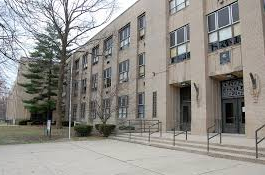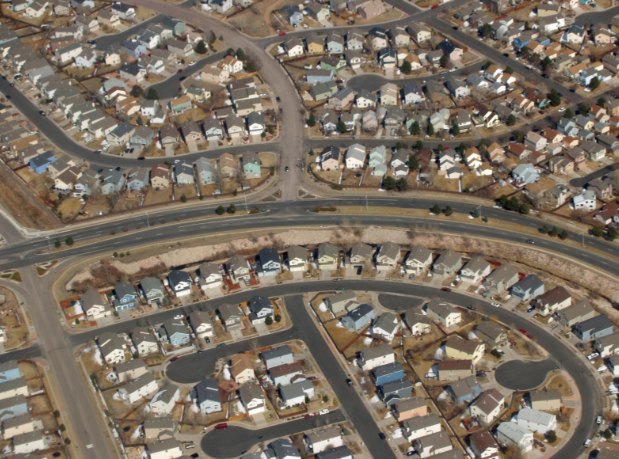The city of Champaign is facing a housing crisis – on this, we can all agree. As population has boomed, housing growth has not followed suit, and we have been building more and more in recent times. The simplest solution is, of course, the suburb – the gold standard of the American Dream. However, I would argue that the image of the suburb that has no doubt appeared in all of your minds – houses spread far apart, big lawns, single-family homes – is not the solution to the housing crisis it first appears to be. Rather, it only kicks the can down the road, introducing a new kind of crisis: that of the budget; yet another burden we place on our children and theirs after them to fix.
You see, the suburb as we understand it is cash-negative. The low population density means that, in the average American suburb, it costs more to maintain infrastructure – things such as water pipes, electricity lines, roads – than is collected from taxes. With this in mind, the image of the suburb can no longer be viewed as an easy method to increase housing for a low cost. Instead, this suburb is an urban parasite – it cannot pay for itself, and so it takes tax money from the more densely populated urban center to fund its sprawl. And, much like a parasite, it is inordinately difficult to remove once it has established itself.
Nevertheless, the promise of the short-term rewards for building suburbs has led to many cities digging themselves into the equivalent of a Ponzi scheme – to make money, they build a suburb, increasing future infrastructure bills, which means when the time comes, they must make more money, so they build a suburb…and the cycle repeats. We are at that very point now – if we are to make a change for a more sustainable and cost effective future, now is the time. This may all seem like conjecture, but I can assure you it is anything but. Two examples of cities that have fallen to this – Houston, Texas and Santa Clara, California – exist, and with my remaining time I will briefly explain them and posit a solution – mixed-use housing.
Houston has absolutely no money to its name. This is a statement of fact – and so how did they get there? It’s simple – through the Ponzi scheme previously discussed. During the growth explosions of the 1950s and 1960s, the city found itself in such a budget boom that it funded an excessive amount of suburbs – and it has paid the price today. It now lacks the money required to pay all the infrastructure replacement bills, which is partially the reason why the Biden administration found it necessary to fund over $461 billion for infrastructure bills.
Santa Clara, California, however, is one of the richest cities in the country: its monthly household income, in 2024, was almost double the national average ($165,352, as compared to $74,580 nation-wide and even $91,905 state-wide). Surely it cannot be facing the same budget troubles as Houston, you’re thinking… and you are right. They’re much worse. Not only is Santa Clara completely bankrupt, they lack the $624 million required to pay all the infrastructure bills generated by their suburban sprawl.
Now, with all of these horror stories about budget deficits and seemingly incurable suburban parasites, you may be wondering if we have any hope – and, I cannot say this emphatically enough, we do. One of the best strategies is that of mixed-use housing; do not stop suburbs being built (as they are, unfortunately enough, one of the best weapons against the housing crisis) but change the ammo being used (as it were). Allow multiple-family housing buildings to be built in the suburbs, small apartment buildings, smaller single-family homes, duplexes – and even small commercial areas. Not only will this increase population density (helping alleviate the problems talked about earlier) but it will decrease car dependency as more areas are walkable, bikeable, or busable – lower road maintenance and emissions.
Even further, allowing small commercial areas will strengthen small businesses and communities, as it is the unfortunate truth that no matter how much a person may hope to support smaller businesses, it is unlikely that they will spend 20 minutes driving to a small shop on the other side of town to pay more for a product they could have gotten five minutes away at a chain store. In other words, allow commercial zoning in your residential areas, and this problem is eliminated.
Finally, mixed-use zoning has one more thing going for it: increased use of public transport. Champaign has one of the best bus systems in Illinois, yet only 24,000 people ride it per day, with most European cities the same size as Champaign transporting more than four times that – though they have many more options than us. Why is that? Simple: density. A bus stop placed in the middle of a suburb will barely reach 450 people; it would be prohibitively expensive to place enough stops to catch every single passenger. However, with mixed-use suburbs, the issue is fixed: enough people live nearby to increase people per stop to up to 5,000 people, increasing bus use and taking cars off the road.
Don’t let all of these facts let you think that people haven’t tried to start this; plans have been made many times over, but they have never quite been realized. Why? Simple: it’s illegal to build mixed-use housing in most places. According to zoning laws, only single-family homes may be built in R1 zoning, which the vast majority of Champaign is zoned for. Thus, one legally cannot build houses other than single-family homes in over 80% of the city; only by petitioning the city council and fighting for change can this be altered.
Really, this problem has not crystallized yet; Champaign’s budget has been balanced for a long while and it is still possible to find places to live outside of the suburbs. However, if we are to make a better future for ourselves, it is imperative that we fight for the right to build better housing.
















































